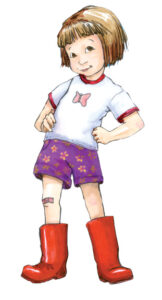
The Education of Ramona Quimby: Kindergarten
 My road trips contain a heavy dose of Beverly Cleary audiobooks. Traipsing around the midwestern United States, my family of six fills the time by listening to the antics of Henry Huggins and Ramona Quimby read aloud by Neil Patrick Harris (quite frankly, it’s his very best work) and Stockard Channing.
My road trips contain a heavy dose of Beverly Cleary audiobooks. Traipsing around the midwestern United States, my family of six fills the time by listening to the antics of Henry Huggins and Ramona Quimby read aloud by Neil Patrick Harris (quite frankly, it’s his very best work) and Stockard Channing.
The fourteen-book literary universe constellates around Klickitat Street, nestled in the shadow of Mt. Hood in Portland, Oregon. The books are filled with stories about nothing, like Seinfeld. Being about nothing also makes them about everything: transitions, family, friendship, middle-class America, financial precarity, elementary romance, death and new life, divorce and marriage, budding independence, sibling rivalry, and, most importantly for our purposes, education.
My family is particularly smitten with Ramona Quimby, who first appears as a minor character in the Henry Huggins series. She takes on a larger role as Beatrice’s exasperating younger sister in Beezus and Ramona (1955) before becoming the eponymous protagonist of seven novels that chronicle her elementary school years. Throughout the Ramona series, readers are offered a window into the family life of the Quimbies and the early public-school education of Ramona first at Glenwood Elementary School and then Cedarhurst Primary.
In this blog series, we take a close look at the fictional educators and experiences that shaped Ramona’s life and mind during her most formative years. From these we will glean pedagogical lessons, from the effects of rituals and social dynamics in the classroom to the importance of deconstructing the threshold between the classroom and the real world.
Kindergarten
At the beginning of Ramona the Pest (1968), we are introduced to Ramona’s young and unseasoned Kindergarten teacher, Miss Binney. To Ramona’s mind, “she could not have been a grownup very long.” Over the course of the novel, what we learn about Miss Binney, above all else, is that she cares deeply for her students. The very first thing that Miss Binney does after introducing herself to Ramona, is to affirm her presence in the classroom: “I am so glad you have come to Kindergarten.” Ramona knows that she matters in this space.
As the novel progresses, Ramona’s varied experiences in the kindergarten classroom are narrated. She learns the puzzling ritual of standing up straight, facing the American flag, and singing the “dawnzer” song. Ramona figures this must be about a lamp because the dawnzer gives off a “lee light:” 🎶“Oh, say, can you see by the dawnzer’s lee light.”🎶 She brings her doll Chevrolet, who is named after her aunt’s car and has green hair from an unsuccessful attempt to blue it like her best friend Howie’s grandmother’s, to show and tell.
Through her Kindergarten experiences, Ramona comes to find that Ms. Binney truly understands her. She asks all the right questions and affirms Ramona in all the right ways.
Until the fateful day that Ramona loses her first tooth. At recess she is on cloud nine about her plan to use the tooth as bait to catch the tooth fairy. Almost unthinkingly, she pulls the curls of her rival, Susan Kushner, just to feel them boing. Miss Binney, looking out for the physical and emotional wellbeing of Susan, tells Ramona that she can only return to the kindergarten classroom if she commits to not pulling Susan’s curls. Stubborn and despondent Ramona, forgetting her tooth in the school building, returns home where she vows to stay until Miss Binney forgets who she is, feeling that her teacher does not care for her anymore.
The Quimbies, apparently very committed to developing their child’s autonomy, allow Ramona to remain absent from kindergarten for several days. On the third day of absence, Ramona receives a letter from her teacher. The prized tooth is Scotch taped to the top of it. When her mother offers to read the letter because Ramona’s literacy is still developing, Ramona snatches it away, declaring, “It’s my letter!” She glances at the first line and can make out the first words: “Dear Ramona Q” (the Q decorated with cat ears, whiskers, and a tail, just the way Ramona herself styles it). Though Ramona can’t actually read the lines of print that follow, she vocalizes what she imagines to be the letter’s content:
“‘Dear Ramona Q. Here is your tooth. I hope the tooth fairy brings you a dollar. I miss you and want you to come back to kindergarten. Love and kisses, Miss Binney.”
In reality, Miss Binney’s letter reads:
“Dear Ramona Q. I am sorry I forgot to give you your tooth, but I am sure the tooth fairy will understand. When are you coming back to Kindergarten?”
What is written in the letter matters far less than what the letter communicates. It is a token of Miss Binney’s affection, and it makes an instantaneous and profound impact on Ramona. Miss Binney does care for her. She cares enough to write Ramona a note in her own hand.
One’s handwriting, especially in personal letters, is a representation of their person. Miss Binney is able to cross the void of Ramona’s physical absence and demonstrate her care for her. A small part of Miss Binney is present in the letter, forming a connection with Ramona and reaffirming their relationship.
This is the pedagogical lesson we can learn from Ramona’s Kindergarten teacher: the simple act of giving students a handwritten note is pedagogically a/effective because it affirms the unique relationship between teacher and student.
Following Miss Binney’s lead, I have made it my ambition to write every student in my classes at least one handwritten note per semester. At the beginning of the semester I make a simple spreadsheet that lists each student, indicates the date on which I gave them a note, and what the note was about. The contents of the notes range from simple affirmations of something that a student said in class to congratulations about their team’s athletic victory or an individual accomplishment.
What is written in the letter matters far less than what the letter communicates.
Watching students’ reactions to receiving an envelope with their name on it at the beginning of class is a great joy. They discreetly open the note and furtively take in its contents, unsure what they have received or why. Even more joyful is seeing how students respond in the days and weeks that follow. Some explicitly offer thanks for being written to, saying that it means a lot. Others change their posture in the classroom, becoming more attentive and more joyful at being greeted at the beginning of class. And it has been enough for some to take additional courses with me or with colleagues in my department, a select few students taking on our department’s minor or major.
At the end of the day, a simple handwritten note, which takes me or Miss Binney approximately two minutes to compose, communicates to a student that they are seen, known, and cared for. One of my colleagues once memorably said, “These students just want to know that their professors give a shit about them.” Giving a shit is a pretty low bar, but it sure goes a long way.
Leave a Reply